
FINDLATER'S CHURCH
The Abbey Church in Rutland Square Dublin was endowed by Alexander Findlater, founder of the wine merchant firm. It is usually called Findlater's Church or even St Findlater's Church.
The following is the fact sheet given out by the Abbey Church.
PRESBYTERIANS IN DUBLIN -The Roots of ABBEY Congregation.
Presbyterians were prominent in Dublin as early as 1594 with the appointment of Rev. William Travers, a Presbyterian clergyman, as the first regular Provost of Trinity College. Two of the first fellows, James Fullerton and James Hamilton, were also Presbyterians.
BULL ALLEY and MARY'S ABBEY.
Almost the earliest known Presbyterian congregation in Dublin was established about 1660 in Bull Alley, a lane running along what is now St. Patrick's Park, under the ministry of Rev. William Jacque. In 1667 this congregation, from which the present Abbey congregation traces its descent, moved to Capel Street and the site of Mary's Abbey. The Abbey had been founded by Godfrey, the Danish King of Dublin, in 948 and finally vacated by the Cistercians in 1641. Meetinghouse Lane, in which the old Chapterhouse of St. Mary's Abbey still stands, takes its name from the Presbyterian building.
THE PRESENT BUILDING.
In the 1860s the growth of the congregation and a substantial increase in rent on the Mary's Abbey property made it desirable for the congregation to seek new premises. By the great generosity of Alexander Findlater, a Dublin merchant, the present site in Rutland Square (now Parnell Square) was bought and a church building was erected at a cost of £14,000. The building is popularly known as 'Findlater's Church' and is referred to by that name in two of James Joyce's novels. The opening services were held in November, 1864.
 |
THE ABBEY CONGREGATION.
During the Easter Rising of 1916 one of the buildings destroyed accidentally by fire was the Union Chapel in Lower Abbey Street whose congregation traced their origins to Huguenots who had come to Dublin in 1690. It appears that some of these Huguenots had worshipped for some time around 1700 on the site of the Mary's Abbey estate too. In 1918 the homeless Union Chapel worshippers accepted the invitation to unite with the Rutland Square congregation under the new name of Abbey Church, which fittingly reflected their mutual connection with the ancient site of Mary's Abbey.
 The West window of the Church. Note the coats of Arms. |
ABBEY CHURCH TODAY.
The present Abbey congregation has about three hundred members who come from all over Dublin. Over the last quarter century their activities have placed increasing emphasis on ecumenism, outreach and cooperation with other communities of all denominations and nationalities. These include links with the Church of Ireland, Methodist, and Roman Catholic churches in our area of the inner city. Shared worship and joint Bible study take place regularly, and there is a monthly exchange of readers with St. Francis Xavier's Church in Gardiner Street. Our young people also exchange visits with youth groups in Presbyterian churches in Northern Ireland, an activity which helps to break down misunderstandings about our different situations and to forge links between the communities.
Because our church is not confined to a parish, we are able to spread our activities
throughout the city. A lot of our work is involved with helping elderly and
underprivileged people, for instance with Meals on Wheels, entertainment for
senior citizens in the area, and the distribution of food hampers at Christmas.
Some years ago we started a training scheme for young people in horticulture,
giving new skills, hope and dignity to the unemployed.
Abbey continues to contribute to the church in the wider world. In recent years,
two members of our congregation - both women - have been ordained as Presbyterian
ministers, and currently two more are training for the ministry .Other members
have become involved in mission work at home and abroad. Many former Abbey members
who have emigrated or moved away from Dublin are active in churches everywhere.
The building itself is used seven days a week by many different organisations,
ranging from choirs who use the premises for practices and recitals to Alcoholics
Anonymous and youth groups, as well as the congregation's own groups.